What now for small modular nuclear reactor construction after high-profile project’s failure?
29 November 2023
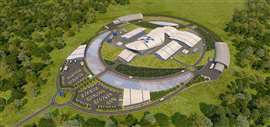 Digital render of what the Carbon Free Power Project SMR would have looked like (Image: Idaho National Laboratory)
Digital render of what the Carbon Free Power Project SMR would have looked like (Image: Idaho National Laboratory)
It was a frontrunner in the slow race to build a small modular reactor (SMR) on a commercial scale.
So when news emerged earlier this month that NuScale’s Carbon Free Power Project in Idaho had hit the skids owing to a lack of appetite from investors, it was big news.
A Bloomberg article declared “hopes of a US nuclear renaissance sink with NuScale”.
Is it that serious? What does it mean for SMR projects in the rest of the world? Could it signal the end of prospects for a large-scale international building programme of SMRs? And even if it doesn’t, what needs to change to make it a reality?
Why the Carbon Free Power Project failed.
First of all though, why did NuScale’s Carbon Free Power Project fail?
SMRs are a new class of smaller, conventional reactors that generate up to 300MW per unit and – in theory at least – can be factory built, sold and delivered rapidly wherever they are required to start generating low-carbon power.
Their smaller size means that they can be deployed on sites that may not suit conventional reactors, while they also benefit from simpler designs using passive systems cooling systems that help to reduce construction costs.
NuScale’s light-water SMR is so far the first and only design to obtain approval from the Nuclear Regulatory Commission.
It also had the advantage of being based at the US government’s Idaho National Lab and was in receipt of significant government funding – in 2020 the US Department of Energy approved a cost share award to Carbon Free Power Project, owned by Utah Associated Municipal Power Systems (UAMPS), that could provide up to $1.4 billion, initially to demonstrate and deploy a 12-module power plant.
Developers changed the design to six modules, each putting out 77MW, as costs rose but estimates put the cost of energy from the plant at $89 per megawatt-hour – well in excess of other low-carbon options like wind or solar.
On 8 November this year, NuScale and UAMPS announced they had agreed to terminate the project. In the end, too few UAMPS members agreed to buy into the scheme. UAMPS CEO and general manager Mason Baker said that it would focus instead on cheaper wind and solar renewable projects.
Multiple different designs for SMRs have been proposed and are at various stages of development. All have to make their way through the laborious process of licensing before they can be manufactured and delivered at a commercial scale.
The cancellation of the CFPP has prompted some to question whether SMRs have a future at all.
NuScale itself certainly remains of the view that they do. In a statement sent to the Construction Briefing, Diane Hughes, the company’s vice president of marketing and communications, said, “NuScale has made substantial progress toward preparing our technology for deployment, maturing our design and developing our supply chain, and our work to date will support future deployments of our SMR technology.
“Materials under production and a substantial body of information developed for the CFPP are project-generic and could be used to support and expedite other NuScale projects, including the agreement we recently announced with Standard Power and ENTRA1. NuScale is working with other customers that have project timeline targets which are similar to the CFPP.
She added that the business continued to see “high levels of interest” from major industrial companies, utilities and local governments.
“NuScale has reached the stage of commercial deployment, and we’ll continue to build on that success with future customers both here in the US and internationally,” she added.
‘The wrong approach’
For Michael Hewitt, co-founder and CEO of IP3 Security, a US-based company that helps host nations to plan, develop, finance and operate new nuclear energy projects, there were flaws in the Carbon Free Power Project that meant it was unlikely to succeed.
He sees a bright future for SMRs, which he argues have a crucial role to play in national security, but the model used to build them needs to change, he argues.
“I disagree with the statement that it [CFPP’s cancellation] is a major setback,” he says.
“It’s important to understand that SMRs are vastly different from large-scale nuclear power plant programmes. There are attributes about the SMR that are supposed to drive down the cost curve, make them easy to produce, be scalable and reduce the engineering, procurement and construction (EPC) risk. But you don’t get to that in practice until you get to a factory build.
“CFPP is a clear example of the wrong approach to building a technology that we’ve been building for 80 years. It’s like going to Boeing and saying, ‘Build me a 737-800, but I’d like you just to build one for me in the garage and if I like it, I’ll order a bunch’.”
By trying to build just an SMR as a one-off project with a mix of government money and investment from utilities to put energy straight into the grid, Hewitt argues that the project failed to capture the cost savings that factory-built SMRs promise.
Challenging US environment
For Tony Roulstone, affiliated lecturer in the Department of Engineering at the University of Cambridge, the US energy market is a difficult environment in which to kickstart the construction of commercial-scale SMRs.
“For at least 10 years, the economics of nuclear look very dodgy in the United States because their gas prices are very low and they are still fracking away like mad. Wind and solar are aided by subsidies but even in their unsubsidised state, they are relatively cheap,” he says.
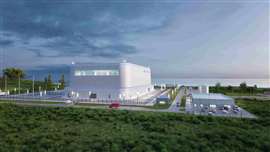 A rendering of how a General Electric Hitachi BWRX-300 SMR plant could look (Image courtesy of GEH)
A rendering of how a General Electric Hitachi BWRX-300 SMR plant could look (Image courtesy of GEH)
“If you’re trying to build a reliable, high-capital-intensive thing like nuclear, it doesn’t really matter whether it’s large or small, it’s very difficult in the US.
Added to that is the fact that the NuScale design has risen in cost. Its reliance on natural circulation to cool the vessels in a large pool ought to make it cheaper than larger nuclear plants. But the large pool requires a lot of expensive reinforced concrete and the plant also has to be earthquake and air crash-poof. “NuScale’s design is very innovative and very safe but it is complicated and it’s not small,” Roulstone adds.
Roulstone notes that there are other projects – notably General Electric and Hitachi’s BWRX-300 reactor – that are showing potential.
“Of course, GE-Hitachi are building it in Canada, because they get better support and better electricity prices,” he says. “It’s interesting that an American company should decide to build across the border. I think this is a proper contender. It’s the next most mature design after NuScale. If they build one in Canada and it works then they will build them in Europe.”
And in Europe, conditions are likely to be more favourable to SMRs, he contends. “Most western markets put some value on net zero and although they may not admit it, they’re willing to pay a premium to have clean energy. That has already been happening in the case of offshore wind,” he says.
“The super-low electricity prices present in the US won’t be here in Europe. It makes the environment for investing in nuclear a bit less challenging. Having smaller units which can be privately funded once they have been proven is an attractive idea, even if governments have to help be the midwife to get the programme going,” he adds.
The case for changing the model
Nonetheless, both Hewitt and Roulstone agree that in order to start getting SMRs constructed in significant numbers, the model needs to change.
“The idea is you only have to spend a billion or two to build a nuclear power plant and if they are standardised and come off a production line, they are not as painful as building an EPR (the third generation pressurised water reactor design), where you have got to find £20 billion or £30 billion,” says Roulstone.
“But the key to SMR cost effectiveness is having a programme where you can build one after the other in a standardised way. I don’t know if the penny has really dropped with the UK government because we haven’t seen that yet. Instead of building them like a Rolls Royce of the 1910s, you have to build them like a Model T Ford of the 1920s,” he asserts.
That’s a point Hewitt expands upon. “We need to get two or three [SMR designs] to full-rate production and then start selling them at scale,” he says.
“If you look at the UK, the government has down-selected to six designs. That’s not really down-selecting, it’s just keeping six technologies in some kind of state of development. What we need to do if we are going to be serious about this (and I think it is critically important that we are), is to be similar to the defence industry.
“We have several largescale vendors that build most of our defence products in the US. We need confidence in the supply chains.”
He advocates governments picking two to three vendors of SMRs and funding the complete non-recurring engineering required to get them through licensing and approvals and on to a low rate of initial production.
Once a small number of SMRs have been built – he suggests around four – he then recommends that the private sector leads largescale production.
“Instead of asking the government to write an equity cheque and asking the utilities or the rate payers to pay for it, you need to turn loose the rigour and the discipline of the private sector and treat this as an infrastructure project,” he adds.
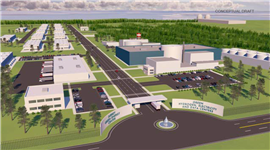 A conceptual draft of how the Surry Green Energy project could look (Image: IP3)
A conceptual draft of how the Surry Green Energy project could look (Image: IP3)
He points to a project IP3 is working on alongside Green Energy Partners to establish the Surry Green Energy Center in Virginia.
The project features a land acquisition for ‘green’ data centres with future options to build hydrogen and nuclear energy production facilities, including a fleet of 4-6 SMRs capable of powering 20-30 data centres.
Virginia processes 70% of the world’s internet data, with the growing number of data centres in the state consuming about 25% of its energy.
“What we have been saying as a company is that the future of nuclear power is SMRs but it’s power to the off-take,” says Hewitt.
“In other words, we are not going to build SMRs just to dump power onto the grid. We want to know exactly what we are going to do with that power. That is precisely the situation we have in Virginia. I already know I am going to develop a gigawatt of data centres there – they will get power from the existing energy mix but they also agree to co-develop SMRs on the site so that when those SMRs are operational, the data centres will get 100% of their power from those plants,” he adds.
Hewitt argues that the future of SMRs is private-sector-led, being government enabled but not government sponsored. “It needs to have the off-takers with them from the very beginning,” he says.
Slow progress
But it’s still likely to be a long time before the construction industry sees a healthy pipeline of work building SMRs on a commercial scale, at least in the western world.
Tristano Sainati, now an assistant professor in the Department of Leadership and Organizational Behaviour at the Norwegian Business School, was involved in writing a paper on the barriers to building SMRs while a lecturer in project management at the University of Leeds in the UK.
The paper, entitled Deeds not words: Barriers and remedies for small modular nuclear reactors, found that perceived investment risk and the availability of cheaper technologies to generate electricity were the main obstacles to construction and that time, cost and risk involved in the licensing process were critical elements for SMR construction.
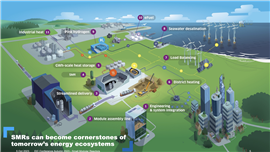
Speaking to the Construction Briefing, Sainati says, “SMRs look very nice on paper. From a technical point of view they are smaller and the designs imply that they are safer, although you don’t know until you actually build and operate them. Engineers are very enthusiastic about the nuclear technology.
“But on the legal and financial side, they are not as enthusiastic as the technical guys because there are many challenges to overcome.”
Sainati pointed out that while it is technically feasible for manufacturers to churn SMRs out in factory-style conditions, the regulatory environment simply hasn’t caught up to the concept.
“The existing licence systems don’t give you any guarantees until you get the final licence,” he says. That means that even after approval of the design, inspectors need to be present during construction before they sign off the plant at the end of the build. It’s a capital-intensive process and while there may be room for such an approach on large plants, it’s a significant barrier when you want to produce smaller plants quickly and more cheaply on a commercial scale.
The second big barrier is on the investment side. Because the capital cost of nuclear is comparatively high, investors want to know that a technology is working and reliable before they take the plunge.
Making a similar point to Hewitt and Roulstone, he says, “Governments need to support the first-of-a-kind and probably second-of-a-kind reactors until they can prove a sufficient level of performance.”
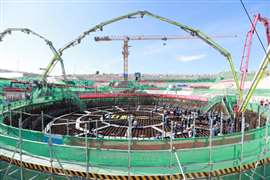 China’s ‘Linglong-1’ small modular reactor has already started construction. (Image: China National Nuclear Corporation)
China’s ‘Linglong-1’ small modular reactor has already started construction. (Image: China National Nuclear Corporation)
There is already strong support in some countries which already have a strong nuclear industry, he points out – particularly China and Russia.
“There are other countries that are moving fast on this and they have full support,” he says. “When the Americans, the Canadians and the British developed this industry, it was mainly nationalised electricity that was fully backed by the government. Then they liberalised and now we are in a position that is a little bit tricky.”
He contends that it will also be difficult to modify the institutions and laws to make it easier and quicker to build SMRs – currently the same rules that exist for the construction of large reactors apply to their smaller counterparts.
“Some people in the nuclear sector think that today, the option you have is still the traditional large reactors. They are the ones we see being built: You have a supplier, you have a buyer, and you have a price. It is something you can deploy. Until you actually deploy small modular reactors, it’s an artificial discussion,” he concludes.
STAY CONNECTED



Receive the information you need when you need it through our world-leading magazines, newsletters and daily briefings.
CONNECT WITH THE TEAM








